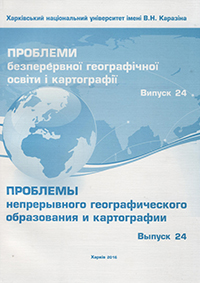New approaches to the formation of concepts in the school course «Socio-economic geography of the world»
Abstract
The article analyzes the problem of concepts’ formation in the course «Socio-economic geography of the world». In the formation of economic-geographical concepts in the 10th form we propose to use various tools of learning and specific approaches. 1st approach - the formation of concepts with the help of maps. Maps are models of economic and geographic facts reflection in the space. Statistics put on the map is an effective tool in the formation of economic and geographic concepts, in the analysis of concrete situation in the country or the world. With the help of maps we propose to form the concepts of megalopolis, urban agglomeration, population reproduction, demographic transition, migration, urbanization, and the like. 2nd approach - the formation of concepts on the basis of charts and diagrams. The diagram is the evidence which determines the dominance of one process or object over another. We propose to use diagrams for the formation of concepts about the occupational structure of population, sex-age composition of the population, exports, imports, employment, etc. The graph performs the function of digital data interpretation, comparison and grouping of objects and processes, illustrating the dynamics of the indicators. With the help of graphs we propose to reflect the dynamics of population, population explosion, migration, fertility, mortality, population density, etc 3rd approach - the formation of concepts on the basis of illustrations and schemes. By the illustrations we propose to form the concepts of suburbanity, pseudourbanity, agriculture, and so on. Schematic images are effective in constructing concepts about the geographical division of labour, depopulation, surrounding geo-environment, monitoring, etc. 4th approach - the formation of concepts with the help of tables. Tables are a transitional link between the text and the graphic image. Using tables we can form such concepts as: Republic, monarchy, life expectancy, types of reproduction, GDP, TNC, human development index, etc. 5th approach - the formation of concepts by explaining. These are the concepts that are impossible or difficult to illustrate: delimitation of borders, political system, democracy, authoritarianism, market economy, and so. The use these approaches in geography lessons will be accompanied by work with the special illustrated Glossary of terms. Now we are preparing such Glossary for publication. It will be issued at the end of 2016.
Downloads
References
2. Kobernik, S.G., Kovalenko, R.R., Skuratovy`ch, O.Ya, (2005). Metody`ka navchannya geografiyi v zagal`noosvitnix navchal`ny`x zakladax: navch.-metod. posib. [Methods of teaching geography at secondary schools: a teaching manual]. Ternopil`: Navchal`na kny`ga, 319.
3. Maslyak, P.O., Olijny`k, Ya.B., Stepanenko, A.B. (1996). Slovny`k-dovidny`k uchnya z ekonomichnoyi i social`noyi geografiyi svitu [Dictionary-reference book for students on economic and social geography of the world]. Ky`yiv: Libra, 328.
4. Nyemecz`, L.M., Zavoloka, Yu.Yu. (compilers) (2011). Slovny`k terminiv ta ponyat` z ekonomichnoyi i social`noyi geografiyi Ukrayiny` [Dictionary of terms and concepts on economic and social geography of Ukraine]. Xarkiv: XNU im. V.N. Karazina, 58.
5. Topuzov, O.M., Samojlenko, V.M., Vishnikina, L.P. (2012). Zagal`na metody`ka navchannya geografiyi [General methods of teaching geography]. Ky`yiv: Kartografiya, 512.
6. Fedij, O.A. (2014). Formuvannya demografichny`x ponyat` u procesi navchannya ekonomichnoyi i social`noyi geografiyi: monograf. [Formation of demographic concepts in teaching economic and social geography: the monograph]. Poltava: PNPU im. V.G. Korolenka, 139.





